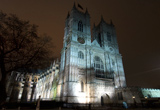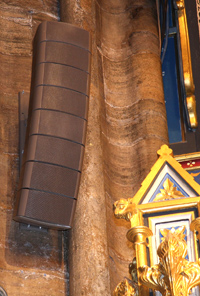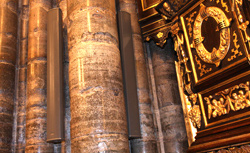 London’s Westminster Abbey recently installed new speech reinforcement, induction loop and CCTV systems, along with ancillary video, audio and data distribution facilities to support its regular services, as well as concerts, lectures and TV broadcast.
London’s Westminster Abbey recently installed new speech reinforcement, induction loop and CCTV systems, along with ancillary video, audio and data distribution facilities to support its regular services, as well as concerts, lectures and TV broadcast.
Designed and specified by audio/video consultant, Michael Hyland & Associates, these included Martin Audio and RCF speaker systems, as well as cabling and signal/control networks.
The Abbey – or more correctly, The Collegiate Church of St Peter in Westminster – stipulated that work be completed ahead of a thanksgiving service to mark the 450th anniversary of Queen Elizabeth I granting a Royal Charter to The Abbey in 1560.

The internal space was divided into 47 separate loudspeaker zones. In one of these – the area between The Nave and The Quire – Martin Audio OmniLine micro-line array loudspeakers have been installed. Because of its discreet style and footprint, this unobtrusive system has become particularly popular in historic buildings and places of worship.
It had been noted that since the screen separating The Nave from The Quire acts as a form of acoustic barrier, it can be difficult for those seated in the Nave to hear the sound of the Choir – especially when the organ is being played loudly. By reinforcing the Choir sound with the OmniLines this problem has been solved. The arrays are mounted at Organ Loft level – at each end of the Quire Screen balustrade. Each hang consists of eight modules – all painted (in RAL 7006) so that they blend into the pillars on which they are mounted.
The suspended microphones above the Quire Stalls provide the input signal to the OmniLines, with the system under the control of the organist.
Modular and scalable, Martin Audio’s award-winning system was purpose-designed for use architecturally, where it claims significant advantages over current DSP-steered columns. Intelligent software enables an array to be configured to deliver sound precisely over any vertical angle to fit the venue profile without spilling onto surfaces where sound is not required. It is suitable for high-quality music reproduction as well as speech in large reverberant spaces, such as churches.

Cabling and network
The installation of the audio, video and control systems was carried out by Whitwam, while responsibility for the cable installation was Albert Walker Electrical. A major part of the site work related to the cable requirements as new microphone, line level, loudspeaker, video and data circuits were installed throughout, with great care taken to conceal new cables and remove all redundant cabling where possible.
In order to reduce the length of the cable runs, equipment was decentralised and racks installed at six key locations interlinked by a fibre backbone. In order to provide resilience and flexibility, two multicore fibres are installed between all rack locations, forming two continuous rings.
The overall routing design is based on a number of DSP units located in racks strategically positioned in different areas of the building. The DSPs are linked via the fibre network using HP ProCurve 2510/24 switches.
The core of the system consists of two powerful processors in the user rack connected locally to mic input modules and line outputs. The audio connections to the remote equipment racks are via CobraNet digital audio channels. There are 32 cabled microphone circuits located in key areas, and a separate page on the touchscreen shows the microphone positions in a mimic of the building. In addition, there are six lapel radio mics along with two stand‑mounted/handheld units.
A paging microphone at the user rack enables ‘live’ announcements to be made throughout the building, and the system also includes a number of pre‑recorded announcements which take account of various emergency situations. Once the announcement is selected, it is automatically fed to all loudspeaker zones.
All seated areas of the building have induction loop coverage, while CCTV coverage has been included with the use of pan/tilt/zoom colour cameras. For major events, hired video monitors are temporarily installed to provide those in the side aisles and other areas with a better view of proceedings (these monitors are also used for events which are televised).
Finally, coverage has been provided for ancillary areas such as the Ringing Chamber, where a local loudspeaker enables the bell ringers to listen to the speech and music elements of the services, while a video monitor enables them to see the output of the CCTV cameras; The Cloister, where the equipment provides a relay capability from The Abbey; finally, St Margaret’s Church, which stands between The Abbey and the House of Commons resulting in it being known as ‘the parish church to the House of Commons’. An audio link to the church’s own local sound system permits the relay of Abbey services (such as The Abbey’s hourly prayers) to St Margaret’s.
For major events, hired video monitors are temporarily installed to provide those in the side aisles and other areas with a better view of proceedings (these monitors are also used for events which are televised). In addition, at each location, there is an audio and a data circuit facilitating audiovisual displays, interactive video, educational workstations and display presentations.
The entire project was carried out under the supervision of The Abbey’s Clerk of the Works. Since being commissioned, the system has been in use for the regular services, along with concerts, drama performances, lectures and TV broadcasts.
More: www.martin-audio.com
More: www.rcfaudio.co.uk